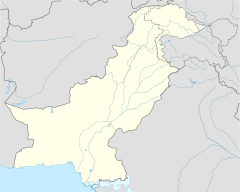Wapda House
| WAPDA House | |
|---|---|

Main facade of the WAPDA House
(November 2006) |
|
|
Location within Lahore (red label)
|
|
| General information | |
| Type | Office building |
| Architectural style | Modernist |
| Location | Mall Road |
| Town or city | Lahore, Punjab |
| Country | Pakistan |
| Coordinates | 31°33′32.60″N 74°19′33.22″E / 31.5590556°N 74.3258944°ECoordinates: 31°33′32.60″N 74°19′33.22″E / 31.5590556°N 74.3258944°E |
| Current tenants | Water and Power Development Authority |
| Completed | 1967 |
| Owner | Government of Pakistan |
| Height | |
| Height | 35 metres (115 ft) |
| Roof | 12 metres (40 ft) |
| Technical details | |
| Floor count | 9 |
| Floor area | 51,000 square metres (549,000 sq ft) |
| Design and construction | |
| Architect | Edward Durell Stone |
| Other information | |
| Number of rooms | ~1,000 |
| Website | |
| www |
|
The WAPDA House (Urdu/Punjabi: واپڈا ہاؤس) is a nine-story office building located in Lahore, Pakistan, that serves as the headquarters of the Water and Power Development Authority (WAPDA). It is one of several prominent government buildings located at Charing Cross on Lahore's Mall Road. The building shares views of the Punjab Provincial Assembly, Islamic Summit Minar, Masonic Lodge, and other key landmarks.
It was designed by the American architect Edward Durell Stone, and completed in 1967.
The Water and Power Development Authority was established in 1958 to develop Pakistan's water and power infrastructure. As the scope of WAPDA's operations increased, so did the number of its offices which were scattered throughout Lahore. The WAPDA House was accordingly conceived as a headquarters that would accommodate all WAPDA offices. The design was prepared by the American architect Edward Durell Stone in 1962.
Around 33 kanals and 6 marlas of land were purchased and the existing Mela Ram and Jodha Mal buildings were demolished to make way for the site on Mall Road, where the building now stands. The total construction cost was estimated at ₨ 42,643,000. Former Prime Minister Zulfiqar Ali Bhutto described the project as a symbol of neocolonialism, and called it a "white elephant" due to its enormous cost at the time. Construction was initiated in October 1963 and completed in 1967. The civil works and electrification were performed by local engineering firms. Around 17,000 tonnes of cement and 5,650 tonnes of steel were used for the construction, along with a large quantity of wood, plate glass and other masonry materials.
...
Wikipedia



